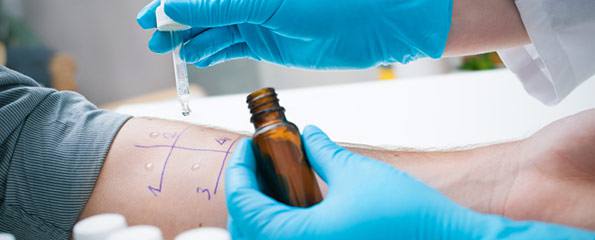- Introduction to skin prick tests
- When are skin prick tests used?
- How to prepare for a skin prick test
- What to expect during a skin prick test
- What do the results of a skin prick test mean?
- Risks of skin prick tests
Introduction to skin prick tests
Avoiding allergens is an important part of the management of allergic diseases such as food allergies, asthma and allergic rhinitis (hayfever). It is therefore important to know what you are allergic to.
Skin prick testing has been performed since the 1860s to determine what a patient is allergic to. It is important to remember that allergy tests cannot be used on their own and must be interpreted in conjunction with symptoms and clinical history. Medicare rebates are available for skin prick tests.
Important note: Unproven allergy tests
There are several methods that claim to test for allergy including cytotoxic food testing, kinesiology, Vega testing, electrodermal testing, pulse testing, reflexology and hair analysis. These tests have not been scientifically validated and may lead you to take unnecessary, costly and (in the case of some changes in diet) dangerous avoidance strategies. No Medicare rebate is available in Australia for these tests and the use of these methods is not advised.
When are skin prick tests used?
Skin prick testing is used to confirm what a patient may be allergic to, which can improve treatment of allergic diseases such as asthma and allergic rhinitis.
How to prepare for a skin prick test
Before skin prick testing is performed, your doctor will take a careful and detailed clinical history looking for relationships between exposure to various allergens and allergic reactions.
Prior to the test, it is important that you do not take any antihistamines or oral corticosteroids for a period of time as directed by your doctor, as they may interfere with the results. If you suffer from asthma, you may continue to take your puffers as normal.
What to expect during a skin prick test
Skin prick tests are usually performed on the lower forearm, but can be performed on any site of the body. Sometimes when there are many allergens that need to be tested it is performed on the back. One of the substances is normal saline, which acts as a negative control (it should always be negative), and one of the substances is histamine, which acts as a positive control (it should always be positive).
Drops of the allergens are placed on the skin, as well as histamine and saline, which are then pricked with a clean lancet. This will feel like a mozzie bite or you may not feel the skin pricks at all. Results are read at 15 minutes by measuring the weal and flare response, or a mosquito-like lump which can occur if you are allergic to that substance. You may experience itching at sites where you react to the allergen. After the test you can put something like calamine lotion on to stop the itching, or take an antihistamine if you react particularly significantly.
As the results are available within 15-20 minutes, you can discuss the results with your doctor at the time of the test.
What do the results of a skin prick test mean?

If the test is positive for a specific allergen, such as house dust mite, it shows that you are sensitised to that particular allergen. This means that you have the ability to mount an allergic response when you are exposed to that allergen. It does not mean that you will necessarily have a clinical allergic reaction to that substance, however, nor does it mean that any reactions will be severe.
The results of the skin prick test need to be interpreted in conjunction with your clinical history and pattern of allergic reactions.
Risks of skin prick tests
If you are severely allergic to a substance, a skin prick test could trigger a severe allergic reaction. For this reason, skin prick tests should only be performed by trained personnel in places where there are facilities to treat severe reactions such as anaphylaxis. These sort of reactions are more common where there is a history of severe allergic reactions, or with allergies to certain foods, such as peanut. In these cases, RAST testing may be a safer alternative.
References
- ASCIA Education Resources. Patient Information Brochure: Allergy Testing. February 2014. (cited 11 September 2015). [PDF]
- ASCIA Education Resources. Skin prick testing for the diagnosis of allergic disease – A manual for practitioners. November 2013. (cited 11 September 2015). [PDF]
- Fanta, C. Fletcher, S. Diagnosis of asthma. UpToDate. 2005. Version 14.1
All content and media on the HealthEngine Blog is created and published online for informational purposes only. It is not intended to be a substitute for professional medical advice and should not be relied on as health or personal advice. Always seek the guidance of your doctor or other qualified health professional with any questions you may have regarding your health or a medical condition. Never disregard the advice of a medical professional, or delay in seeking it because of something you have read on this Website. If you think you may have a medical emergency, call your doctor, go to the nearest hospital emergency department, or call the emergency services immediately.








